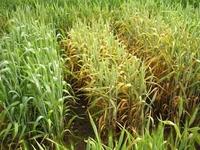Europe
December 5, 2013

 ENDURE researchers have used sophisticated modelling techniques to demonstrate how mixing different cultivars of the same crop species can be a useful tactic in managing multiple diseases, writes Natalia Sapoukhina.
ENDURE researchers have used sophisticated modelling techniques to demonstrate how mixing different cultivars of the same crop species can be a useful tactic in managing multiple diseases, writes Natalia Sapoukhina.
The theoretical study on the deployment of quantitatively resistant wheat varieties in cultivar mixtures provides insights into the effects of using quantitative plant resistance on pathogen dynamics. It also provides guidance on desirable associations of cultivars and on optimised diversification strategies.
The study, conducted by ENDURE’s 'exploitation of plant genetic resistance' working group and published in New Phytologist, clarifies the principles for the successful use of quantitative wheat resistance in management of wheat yellow rust.
In the paper, researchers provide the conditions under which cultivar mixtures that divide the pathogen population into non-specialised pathotypes can result in both an acceptable degree of disease severity and a positive absolute disease reduction.
They built a parsimonious host-pathogen model describing the dynamics of competing pathogen strains spreading over a genetically diversified host population distributed in a two-dimensional environment. Using the parameterised model for a wheat-yellow rust system, the authors studied the effectiveness of two- and three-component random cultivar mixtures in which the degrees of susceptibility and proportions of mixture components were varied.
They report that “... a more effective use of quantitative resistance in mixtures involves reinforcing the effect of the highly resistant cultivars rather than replacing them. We highlight the fact that the judicious deployment of the quantitative resistance in two- or three-component mixtures makes it possible to reduce disease severity using only small proportions of the highly resistant cultivar. Our results provide insights into the effects on pathogen dynamics of deploying quantitative plant resistance, and can provide guidance for choosing appropriate associations of cultivars and optimising diversification strategies.
“Despite the high potential value of cultivar mixtures in disease management, the current standards of uniformity, marketing restrictions, and processing quality impede their wide use. In addition to technical barriers, there is a dearth of the mathematical models that could help in selecting component cultivars and in tailoring cultivar mixtures to local pathogen populations.
“Here, we demonstrate that a parsimonious, spatially explicit model of a reaction-diffusion type could fill this gap. Our study contributes to the development of a general framework of mixture theory that could allow us to design diversified agroecosystems that exert low selective pressure on the pathogen populations. The model can be used in multi-disease control by intercropping as well. It provides theoretical support for future experimental research intended to develop disease control strategies based on diversified host populations.”
Taken from: Sapoukhina N., Paillard S., Dedryver F., and C. Vallavieille-Pope. 2013. Quantitative plant resistance in cultivar mixtures: Wheat stripe rust as a modeling case study. New Phytologist 200: 888-897. DOI: 10.1111/nph.12413
To read the abstract and obtain the full paper: New Phytologist